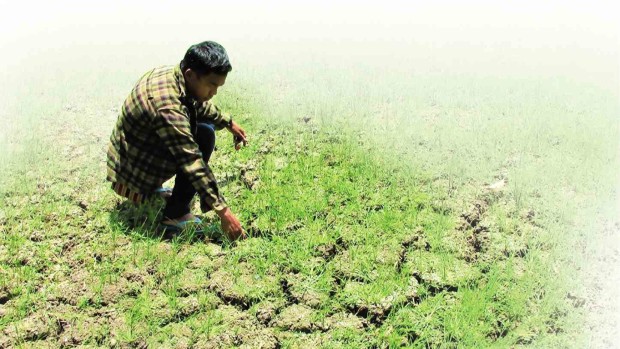Puerto, Davao Oriental in state of calamity

ALTHOUGH patches of green are still visible in farms in Albay province, cracks on the soil start to worry farmers as the drought continues. MICHAEL B. JAUCIAN/INQUIRER SOUTHERN LUZON
TWO MORE areas have been declared under state of calamity as a result of the prolonged drought.
The provincial government of Davao Oriental and the city government of Puerto Princesa made the move as the drought continued to destroy crops and push farmers to desperate measures.
Davao Oriental Gov. Corazon Malanyaon, citing a report by the Provincial Agriculture Office, said the drought had damaged crops and livestock in the province’s 10 towns and the city of Mati.
Malanyaon said a total of 3,870 farming families were severely affected by the drought that had already damaged more than 3,000 hectares of farms in Davao Oriental.
The provincial government initially placed the amount of damage at P42.1 million.
Article continues after this advertisementAt least four local government units have earlier declared states of calamity. These are the city of Mati and the towns of Tarragona, San Isidro and Lupon.
Article continues after this advertisementWith the declaration, the provincial government can now access 5 percent of its calamity fund for relief efforts.
In Puerto Princesa City, the extreme heat has dried up water sources, prompting the city council to declare a state of calamity.
The City Disaster Risk Reduction and Management Office (CDRRMO), in a report to the city council, said water level in the city’s underground aquifers, which supply the bulk of the city’s needs, had reached the critical mark, prompting the local water cooperative to ration water since late March.
The CDRRMO also noted an increase in grass fires this year, with 91 cases reported in the first quarter of the year, surpassing 70 cases last year.
City officials are banking on the declaration so Puerto Princesa can tap local government resources in responding to a calamity situation.
The Department of Science and Technology, which has been releasing El Niño advisories, earlier identified Puerto Princesa as among the areas in the country expected to experience drought and “below to way-below-normal” rainfall.
While the CDRRMO report did not cite figures, it said the city agriculture office reported widespread agricultural damage due to the dry spell. It said agricultural productivity was in a decline because of the warm temperature that affected crops in various stages of development.
A report from the Philippine Atmospheric, Geophysical and Astronomical Services Administration said the country would experience the impact of El Niño until the second quarter of this year.
In the Bicol region, at least 473 hectares of land were damaged by El Niño since January, the National Irrigation Administration said. Nico Alconaba, Inquirer Mindanao, and Redempto D. Anda and Michael B. Jaucian, Inquirer Southern Luzon